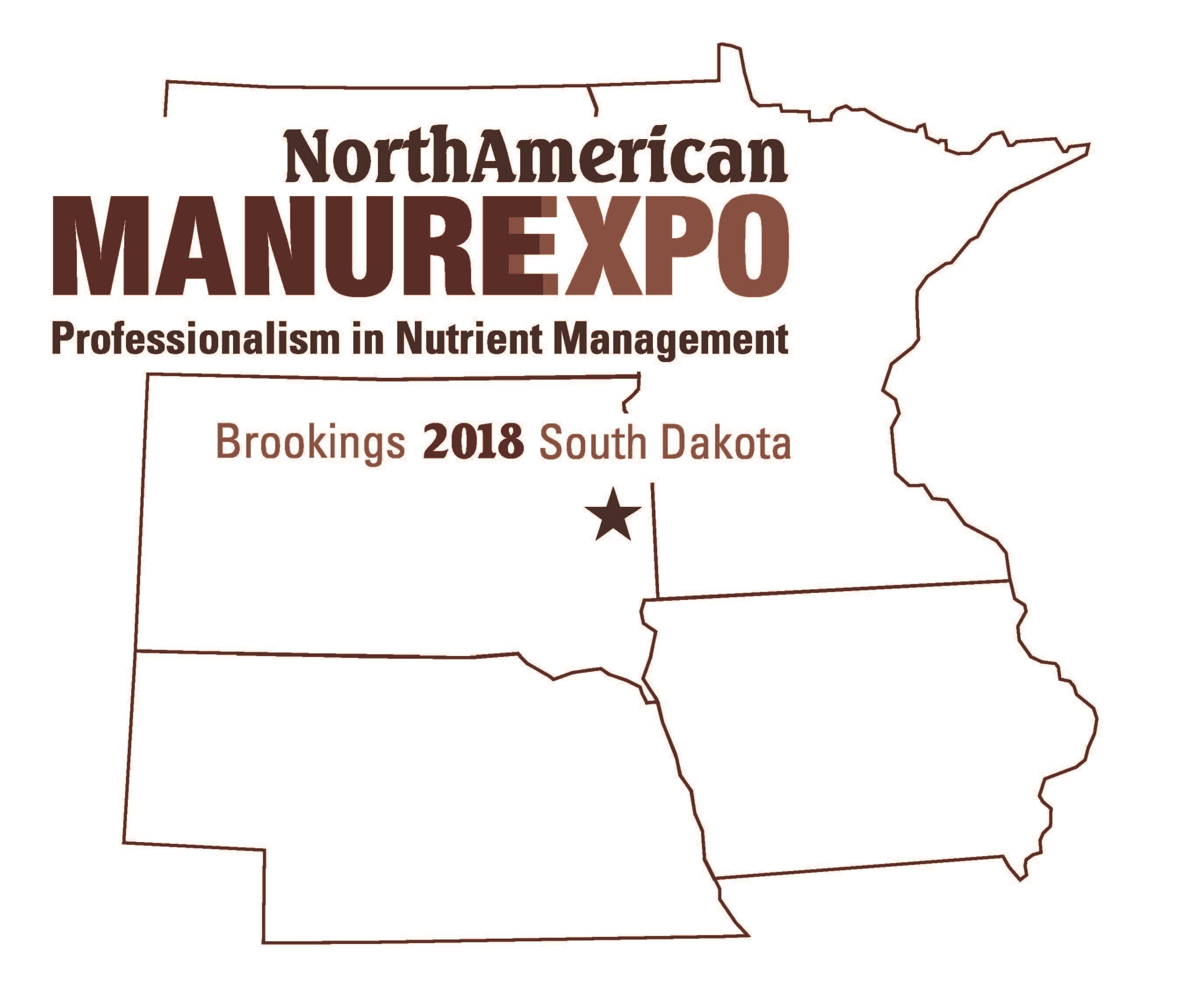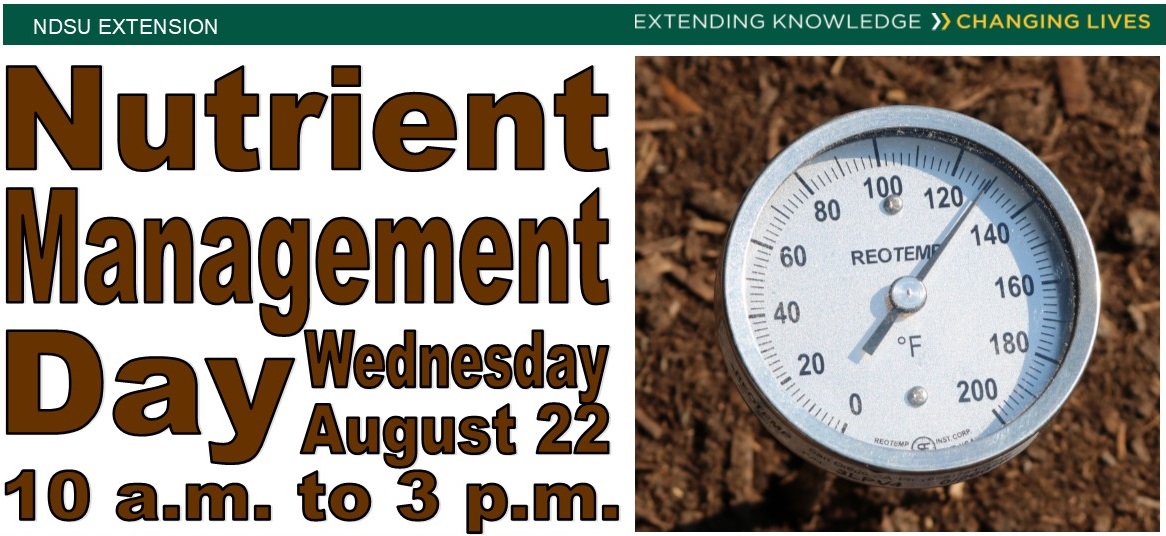2018
Corn, Dry bean and Soybean Production Tour at CREC on August 23
What are the most economically important disease threats in corn, soybean and dry bean, and how to manage them? How can I get the most return on my starter fertilizer in corn and dry bean? Why should I consider using rye in my soybean or dry bean fields? Farmers and crop advisers will have these and other production questions answered during the annual row crop field tour on Thursday, Aug. 23, at North Dakota State University’s Carrington Research Extension Center.
Registration (with refreshments) will start at 4 p.m. and the tour will begin promptly at 4:30.
Tour topics are:
- Goss’ wilt and leaf blight management in corn
- Managing soybean cyst nematode and root diseases in soybean and dry bean
- Choosing row spacing to minimize the impact of white mold in soybean
- Optimizing fungicide control of white mold in soybean and dry bean
- Research update with rye as a cover crop for soybean and dry bean
- Soybean and dry bean variety performance and selection
- Corn and dry bean starter fertilizer research update
A supper sponsored by North Dakota Soybean Council and Northarvest Bean Growers Association will follow the tour.
Continuing education credits in crop (1), pest (1), nutrient (0.5), and soil and water (0.5) management will be available for certified crop advisers participating in the event.
If you have questions you may contact Greg at 701-652-2951.
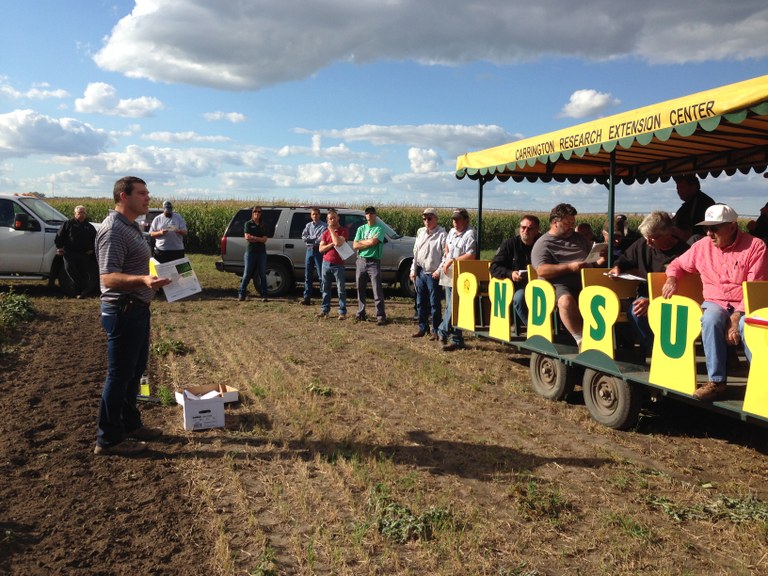
Greg Endres
Gregory.Endres@ndsu.edu
Agronomy Extension Specialist
August is Full of It!
Green stuff? Brown stuff? The brown stuff makes green stuff? I could go on and on. Jokes in the “manure world” are endless and make me smile. If you’re looking for your fill of fun and education on manure and nutrient management, August is the month for you!
You’ve heard me talking about it for a year and now it’s finally time. The North American Manure Expo will be co-hosted by NDSU Extension on August 15-16 in Brookings, SD. If you have livestock that produce the brown/green stuff, have ever wondered about using manure as a fertilizer, or just think the Manure Expo sounds interesting, then plan to head south next week. You will not have the opportunity this close to home to have experts in the industry (including livestock and crop farmers) answer your questions at the educational sessions, see the latest manure spreading equipment go head-to-head on the demonstration fields, and attend the largest (only? But it IS big!) manure industry expo. Tours on August 15 are $20 to hold you seat on the bus. The Manure Expo on August 16 is free, but registration is appreciated. If you make the trek south, make sure you find me and say hi!
If sticking closer to home is more your thing, don’t worry, because the week following Manure Expo is Nutrient Management (NM) Day at the Carrington Research Extension Center. Plans are finalized and registration is open for the August 22 event. Every year I wonder if there’s anything new I can share with you and every year I get more excited once NM Day is planned. This year you will find me in the front row taking in all the latest information: new technologies in the compost industry, how to manage herbicide residuals in compost and manure, integrating the manure spreader with autosteer and adjusting the application rate automatically, and checking out actual results of product inconsistency and the importance of knowing what’s being spread where. We have speakers from NDSU Extension, Hefty Seed Company, Centrol Crop Consulting, Corteva Agriscience, and Topcon Agriculture joining us. Folks, I haven’t been this excited for a NM Day since…last year! You can find more details on the LEM website: www.ag.ndsu.edu/lem. The event runs from 10 a.m. – 3 p.m.
And if you’re more of an on-the-farm person, this final manure event is for you! On Friday, August 24 we will be at Bloms Land and Cattle, LLC in Renville County for a manure compost demonstration day. The event will run from 10 a.m. to noon. We will discuss the process of composting manure, do a live turner demonstration, hear from the producer who has been running the turner and answer questions about using compost as a fertilizer. This event is free and there is no registration. Event details can be found here: https://www.ag.ndsu.edu/lem.
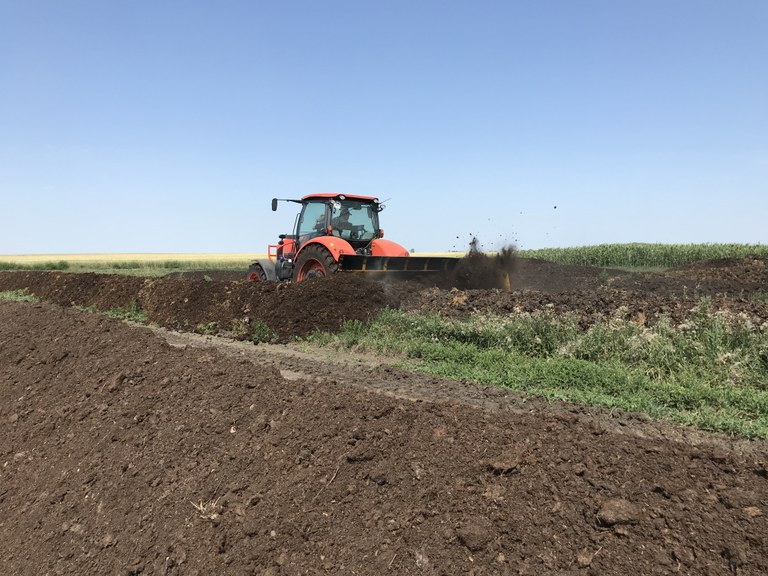
Manure Compost Demo Day on-farm site.
August will be a (slurry) flurry of manure excitement and I hope to see you at one of these events. Let me know if you have any questions mary.berg@ndsu.edu or 701.652.2951.
Mary Berg
mary.berg@ndsu.edu
Extension Specialist/ Livestock Environment Management
Good Bugs II: Farming with Native Beneficial Insects for Pest Control
The Carrington REC is hosting the program Good Bugs II on Thursday, August 16th, 8:00 a.m. - 4:30 p.m. (and in Grand Forks on August 15th). It will be both an overview and have some specific information on beneficial insects and the habitat they require. Insects include pollinators, but also predators for crop pests. We will discuss what both homeowners and farmers can do to increase or improve the necessary habitat.
Register here: http://www.ndswcs.org/news.htm!
We hope to reach gardeners/homeowners, farmers, ranchers, certified crop advisors and Extension agents. If you enjoy insects as much as I do, and hate pests – this workshop is for you! (Of course, you can always forward to your buggy friends.) There are a lot of simple things we can do in our local environment to help insect communities.
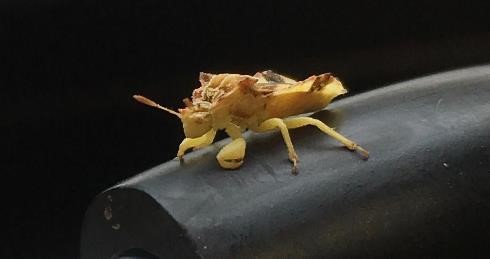
1: Friend or Foe? -Ambush Bug
At the CREC orchard, we have a great plain of dandelions just south of the orchard and many more within the fence. These, along with willows in the shelterbelt, provide very-early spring food sources for bees and warblers. Half the fenced area is old tree trials that burst into bloom in mid-summer with clovers and alfalfa. After Field Day, I stop mowing the orchard and let the clovers get going for fall flowers. Over the past 4-5 years, I feel like I really see a lot more birds nesting and good numbers of wild bees and syrphid flies. We find several kinds of beneficial wasps, too. I could still use more early bumble bees though.
Conservation biological control is a science-based pest management strategy that seeks to integrate beneficial insects back into cropping systems for natural pest control, ultimately reducing and in some cases eliminating the need for pesticides. Participants will learn how common farm practices can impact beneficial insects and how to assess and create farm habitat for beneficial insects.

2: Friend or Foe? -Katydid Nymph
The Good Bugs II meeting is put on by Xerces Society, SCD, NRCS and Extension. Its real name is “Farming with Beneficial Insects for Pest Control” but we are going with Good Bugs II. Hope to see you there!
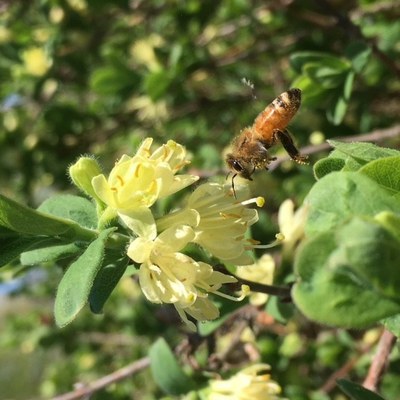
3. Friend or Foe? -European Honey Bee
Answers to the Friend or Foe questions below:
- Ambush bugs are smaller, heavier-bodied cousins to assassin bugs but instead of stalking other insects, they wait motionless for their prey to wander near. The ambush bug seizes the insect with its powerful forelegs and quickly dispatches it with a stab from its sharp beak. Ambush bugs eat everything that walks by, so they eat insects both harmful and helpful to plants.
- Katydids include members that eat both plant parts (leaves, flowers, seeds) and that are exclusively predatory on other insects or snails. So, they are both friend and foe. However, the one pictured here is a plant eater – so probably a foe.
- Honey Bees are tricky. They are friends to humans since we get economic gain from their work. However, they are foes of other wild bees, the ones most helpful to pollinating the world around us. Honey bees strip nectar and pollen early in the day leaving little for their wild cousins. In addition, they may carry diseases that can be transmitted to wild bees just by visiting the same flowers.
Kathy Wiederholt
kathy.wiederholt@ndsu.edu
Fruit Project Manager
Is It Over Already?
Last week was a busy one for us here at the CREC. Those who attended know that we held our Annual Field Day on July 17th. We also had follow up field events the rest of the week which made time fly past. We always enjoy having visitors (even during our busy seasons) and welcome you to call (701.652.2951) or stop by the office anytime to schedule a tour. Following are a few highlights from our 2018 Annual Field Day.
The agronomy tours had an excellent turnout to go along with a great lineup of speakers and topics. Guests got to hear the latest information about remote sensing, protein premiums, field pea and soybean marketing, cover crops, wheat variety development, legume disease management, corn growth and development, and more! All in attendance had something new to think about for their own operations. - Mike Ostlie
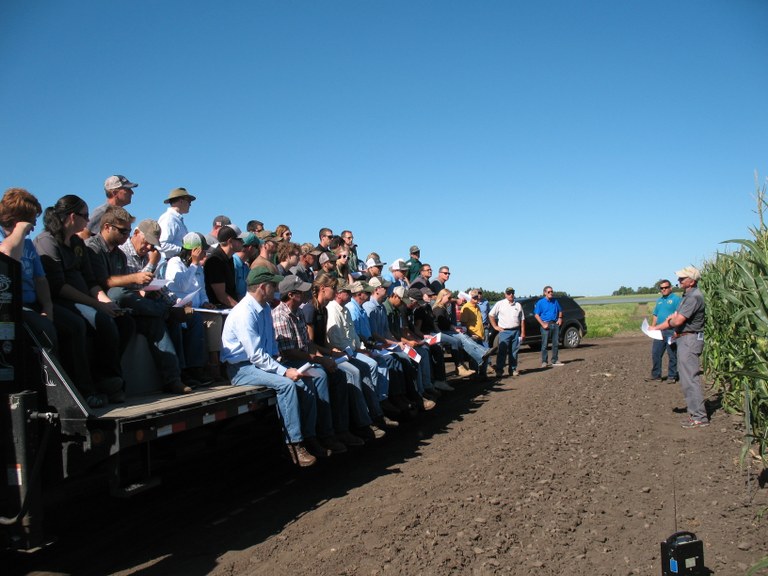 Participants of the 2018 CREC Annual Field Day agronomy tour learn about corn growth and development.
Participants of the 2018 CREC Annual Field Day agronomy tour learn about corn growth and development.
Attendees of the fruit project tour enjoyed a beautiful day as they received information on growing aronia from Dave Vander Werf. Vander Werf and his wife grow and harvest 15 acres of aronia, which was planted in 2012, near Hawarden, IA. In the afternoon, guests enjoyed a taste of aronia ice cream and frozen aronia berries while they listened to a discussion on aronia sales and marketing. About 55 people attended each session. – Kathy Wiederholt
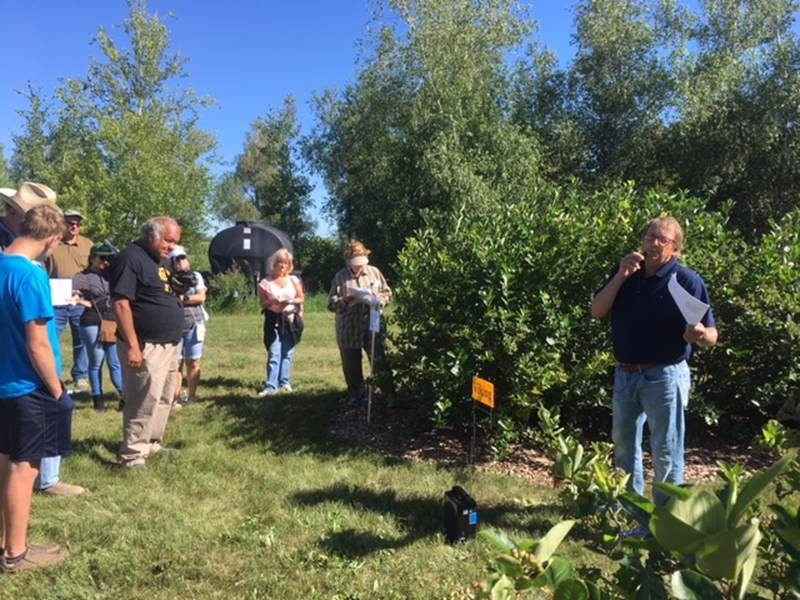 Dave Vander Werf and guests standing near aronia shrubs at the 2018 CREC Annual Field Day fruit project tour.
Dave Vander Werf and guests standing near aronia shrubs at the 2018 CREC Annual Field Day fruit project tour.
Fifty-nine people attended organic tour this year. Ancient grains, einkorn, emmer, and spelt were featured with presentations covering topics from production research to current marketing trends. We also learned about current development related to organic field pea varieties that will be available to organic farmers in the near future. Current organic oat was also highlighted. Overall, the organic tour had a good representation from both the public and private sector educating the participants on topics related to organic research conducted at the CREC. – Steve Zwinger
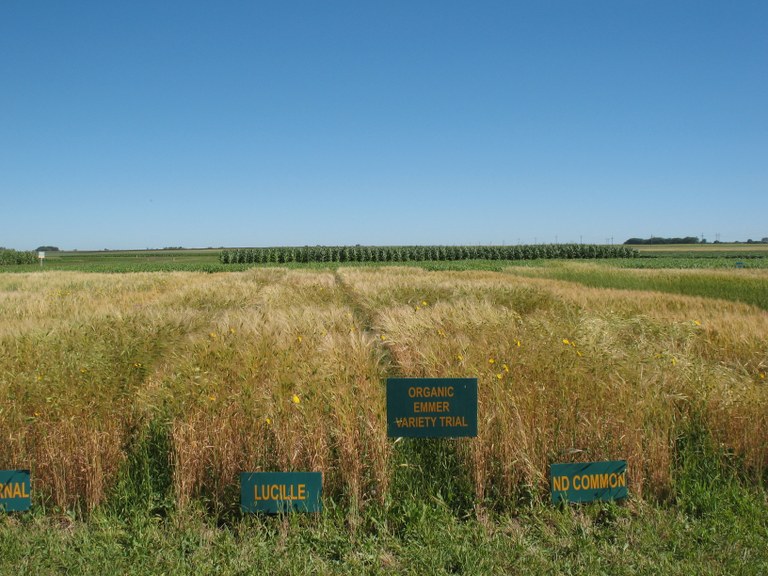 Organic emmer was a focus area for the 2018 CREC Annual Field Day organic tour.
Organic emmer was a focus area for the 2018 CREC Annual Field Day organic tour.
The livestock production tour featured a variety of presentations from CREC, Extension and other main campus guests. Presentations covered topics including beef quality assurance, feedlot management, and reproductive management in beef cows. Demonstrations highlighted turning manure compost and ultrasound of beef cows for pregnancy determination. Approximately 40 people joined the livestock tour this year. - Bryan Neville
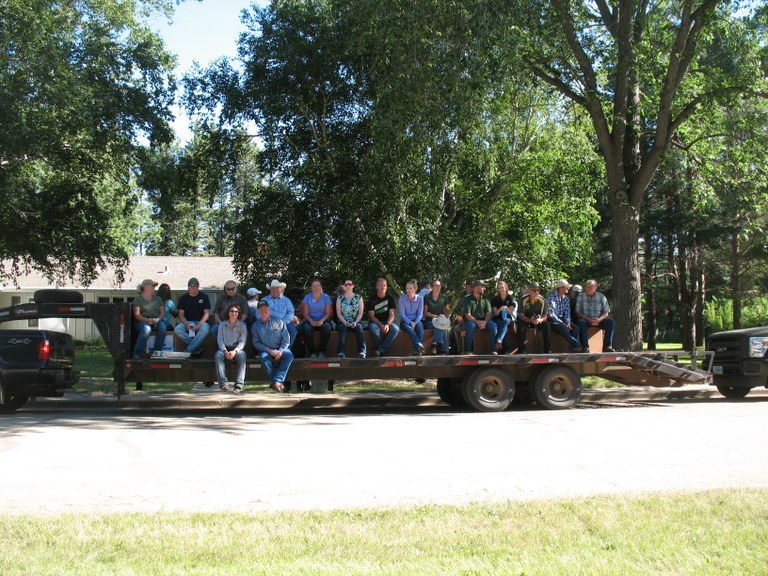
Folks gathering on the wagon heading to the livestock production tour during the 2018 CREC Annual Field Day.
As always, be sure to send us tour stop suggestions for next year!
Mary Berg
Mary.Berg@ndsu.edu
Extension Specialist/Livestock Environmental Management
Tomorrow is the Day!
Tomorrow is our annual Field Day – our largest showcase event of the year.
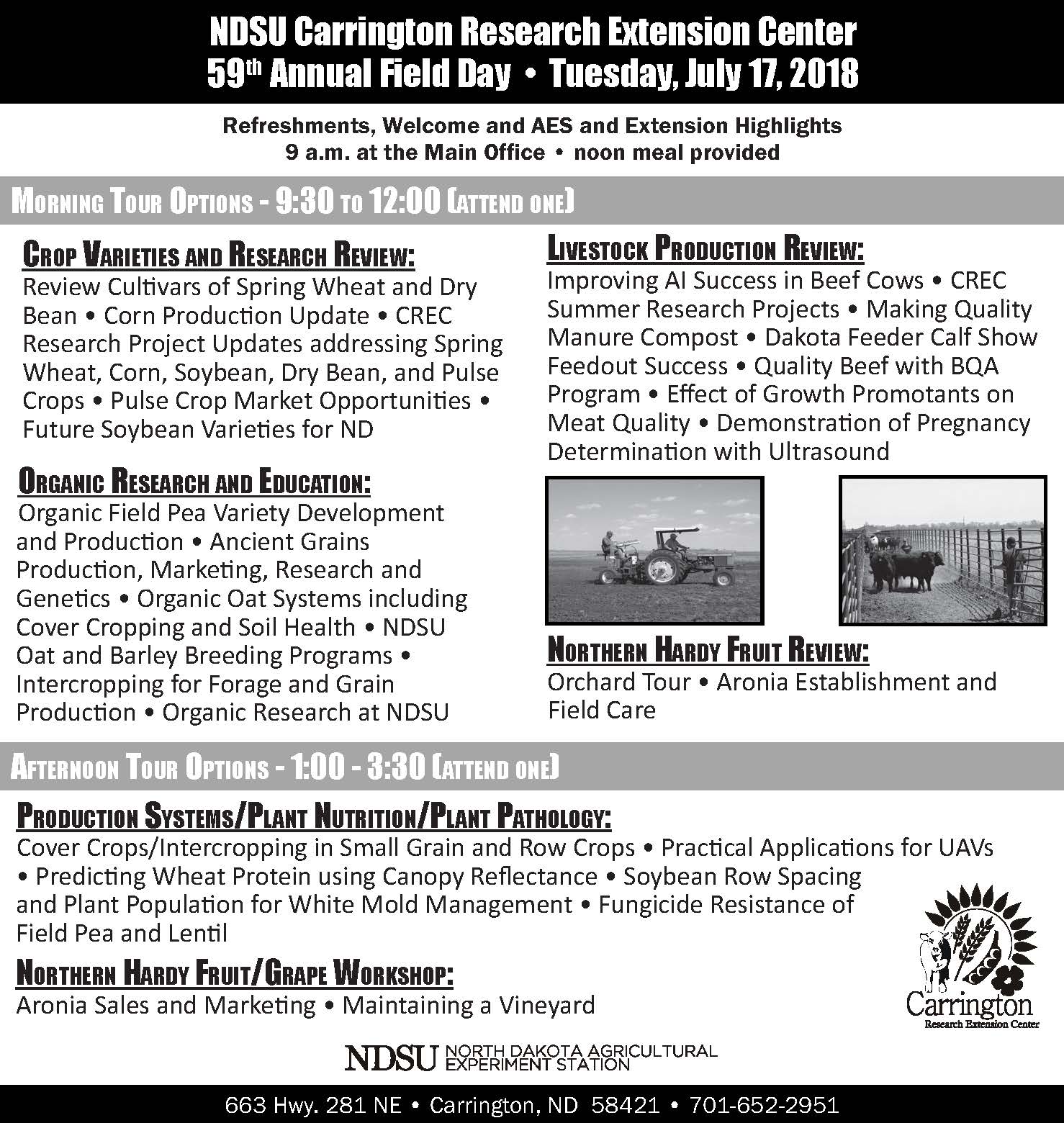
PLEASE JOIN US!
Of course, we are always available to answer your questions on the phone or in person, and we host many tour groups each summer. Please call to schedule your group, whether everyone is local or you have a carload of visitors from out of state. We cater tours to the size and interest of your group. We hope to see you soon.
CREC Staff
701-652-2951
Field Day 2018!
Next week, on Tuesday, July 17, we host our Annual Field Day – a giant showcase of variety trials, breeding (crops AND livestock), research trials, production practices, fruit trees and shrubs, and an opportunity for you to look around the Carrington Research Extension Center.
Along with specialists and researchers from the NDSU campus and our fellow REC’s across the state, we are prepared to demonstrate and discuss our research with you.
Choose from one of four morning tours:
- Crop Varieties and Research Review: Spring wheat, dry bean, soybean, corn, and pulse crops.
- Livestock Production Review: Artificial insemination, summer projects, manure compost, Dakota Feeder Calf Show, Beef Quality Assurance, use of growth promoters, and pregnancy ultrasound demo.
- Organic Production Review: Ancient grains, oats, barley, field pea, and intercropping systems.
- Northern Hardy Fruit Project: Orchard tour with special emphasis on aronia establishment.
Join us for a free lunch at noon.
Afternoon events include a second ride on the tour wagons to investigate cover crops and intercropping, and practical applications for UAVs. Plant pathology conversations will include row spacing and plant population for white mold management, fungicide resistance in field pea and lentil, and droplet size and canopy coverage to control white mold.
Two special fruit events are also scheduled for the afternoon: Iowa aronia specialist Dave Vander Werf will talk about aronia sales and marketing, followed by “Maintaining a Vineyard,” part two of the three-part series “Growing Grapes in North Dakota” sponsored by the North Central Research Extension Center.
All of these events are free and open to the public. Visitors are welcome to walk the CREC grounds, especially to view approximately 60 live specimens in our Weed Arboretum or to check out the 40 labeled tree varieties on our grounds.
We begin at 9:00 a.m. with a welcome from CREC director, Blaine Schatz. Lunch is at noon, and afternoon events resume at 1:00 p.m.
We hope to see you on July 17.
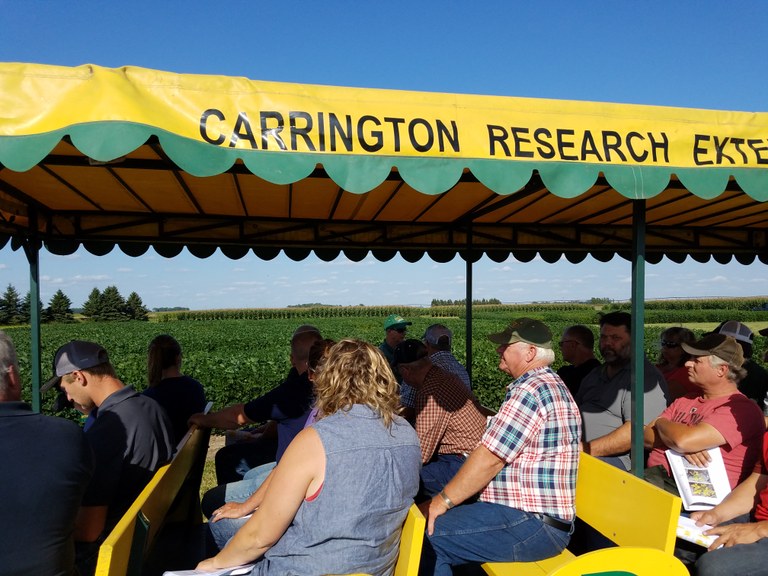
Grab a seat on one of the CREC's Annual Field Day Tours on Tuesday, July 17.
Happy Fourth of ‘Bee’ly
Did you know that is takes roughly 2 million visits to a flower for bees to make 1 lb of honey? Right now we are entering peak blooming season for many North Dakota crops, including soybeans, canola, flax, and dry beans. Many of our flowering crops do not require bees for pollination, yet we know that bees are collecting pollen from them anyway. Have you ever wondered if those bee visits are affecting your crop yields? That is exactly what we are hoping to find out at the Carrington Research Extension Center.
Bee culture is complicated. I like to view bees in two categories; honey bees and native bees. We have a few research projects aimed to answer questions about both categories. This year we have installed scales and pollen traps on the honey bee hives at the CREC. With the diversity of flowering crops grown here, we are hoping to learn which crops the bees are visiting most (by testing the pollen) and learn about the amount of honey being produced throughout the year. Following is a graph depicting the weight gains of one hive since they’ve been in place (Figure 1). The hive weight changes regularly because 1) the bees leave during the day (dips) and come back in the evening (humps), and 2) because they are making honey.

Figure 1. Temperature and weight changes of a bee hive over nearly three weeks in June 2018. The green line indicates temperature and the orange indicates hive weight.
The other category of bees is the native pollinators. It is more difficult to measure what they do on a daily basis due to the number of species and living spaces involved. But, we can start to estimate their contributions to agriculture. We have started a few projects that will be identifying which species interact with our crops and how much they may be contributing to crop yields. Figure 2 shows a flax study that will either allow insect pollination or prevent it from happening. We will measure yield and identify pollinator visitors from this trial to see if pollinators could be benefiting flax in any way. This ties into a larger project that will begin next year which will try to measure the influence of conservation pollinator plantings on the surrounding crops. To summarize, we know that pollinators are important to North Dakota’s landscape, we just want to know which cash crops they affect and by how much.
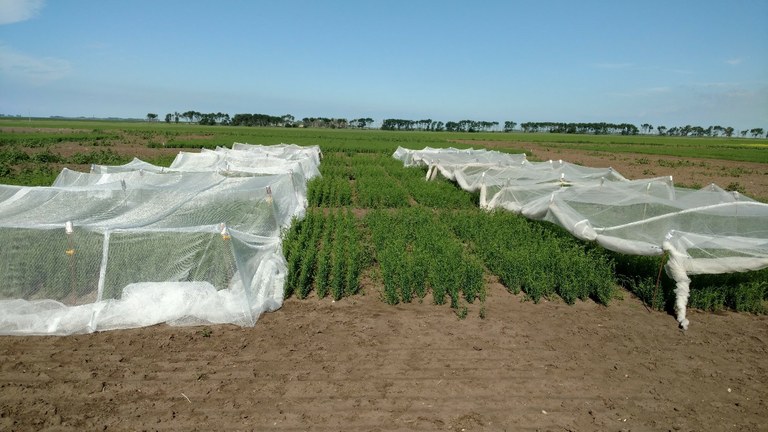
Figure 2. Nets set up for bee exclusion (left) and bee inclusion (right) in flax at the CREC.
Mike Ostlie
Mike.Ostlie@ndsu.edu
Research Agronomist
Using Remote Sensors to Discriminate Between Healthy and Less Healthy Crops
Remote sensors are a valuable tool for conducting research at the CREC. This 2018 cropping season, ground-based sensors (GreenSeeker, Crop Circle) and unmanned aerial systems (UAVs) are being used to assess the effect of fertilizer application on crop health (vigor).
When turned on above crop canopy, these sensors absorb light reflected by the canopy. The sensors produce numbers called NDVIs that are a measure of crop vigor. More abundant canopy produces higher NDVIs (between 0 and 1). Here are examples of mid-season assessment of wheat and barley for some 2018 trials at the CREC.
Figure 1. Two barley varieties gave higher NDVIs indicating a more vigorous crop from sulfur fertilization.
Figure 2. Phosphorus application enhanced wheat vigor as expressed by NDVI.
To decide whether top-dressing N would improve grain yields, the NDVI for a well fertilized plot (160 lbs N in this trial) was divided by NDVI of the check (which did not receive N fertilizer). This ratio gave us the response index (RI). An RI of 1.1 suggests we would expect a 10% yield increase if additional N was applied (Table 1).
Table 1. A ground-based sensor was used as a decision tool to
determine top-dress N was not needed in this trial to enhance yield.
For further reading, visit a well written summary of remote sensor use in side-dress N applications for corn in North Dakota by Franzen, et al. available here: Active Optical Sensor Algorithms for Corn Yield Prediction and a Corn Side-dress Nitrogen Rate Aid.
Jasper M Teboh, Ph. D.
Jasper.Teboh@ndsu.edu
Research Soil Scientist
Aronia Featured at CREC’s Field Day
Aronia has been a very successful fruit for the CREC and other growers across North Dakota. Right now it looks like a bumper crop with almost all of the flowers setting fruit.
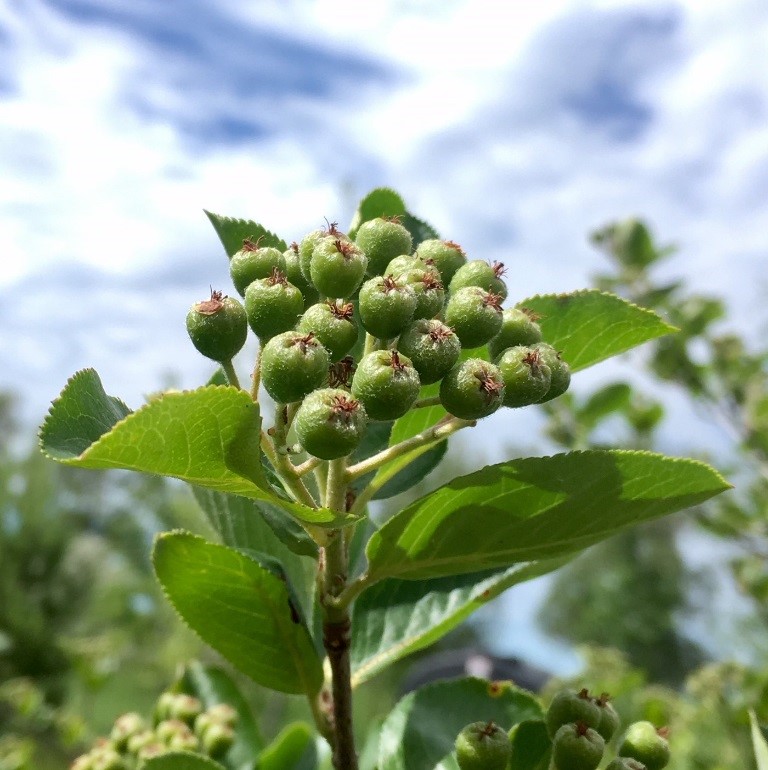 2018 - Developing aronia crop at the CREC.
2018 - Developing aronia crop at the CREC.
Should you invest in growing aronia? Get more information at the annual CREC Field Day at 9:00 a.m., Tuesday, July 17, 2018, where aronia production will be a featured topic. At 1:00 p.m., we will meet indoors to discuss growing and marketing aronia.
Our invited speaker is Dave Vander Werf, of Sioux Center, Iowa. He grows 15 acres of irrigated Aronia. During the morning field tour, he will talk about aronia production and plant care. After lunch, he will make an indoor presentation about the current realities of marketing aronia berries and finding a buyer.
Aronia fruit has the highest levels of polyphenolic compounds (anthocyanins, flavonols, etc.) that have been measured in any fruit. These nutraceutical compounds are 3-times higher in aronia than in blueberries, blackberries and black currants.
Each year, the CREC fruit project receives inquiries from ND landowners interested in planting a permanent crop to diversify their income. Aronia is a woody crop that does not require intensive management. It is very amenable to mechanical harvesting and is being planted as a cash crop across the Midwest. Aronia growers in ND are very successful with this productive crop. A grower can expect to harvest three pounds of fruit per plant in the third year and 15 pounds per plant after the crop is 5 years old (based on dryland production at the CREC and regional reports).
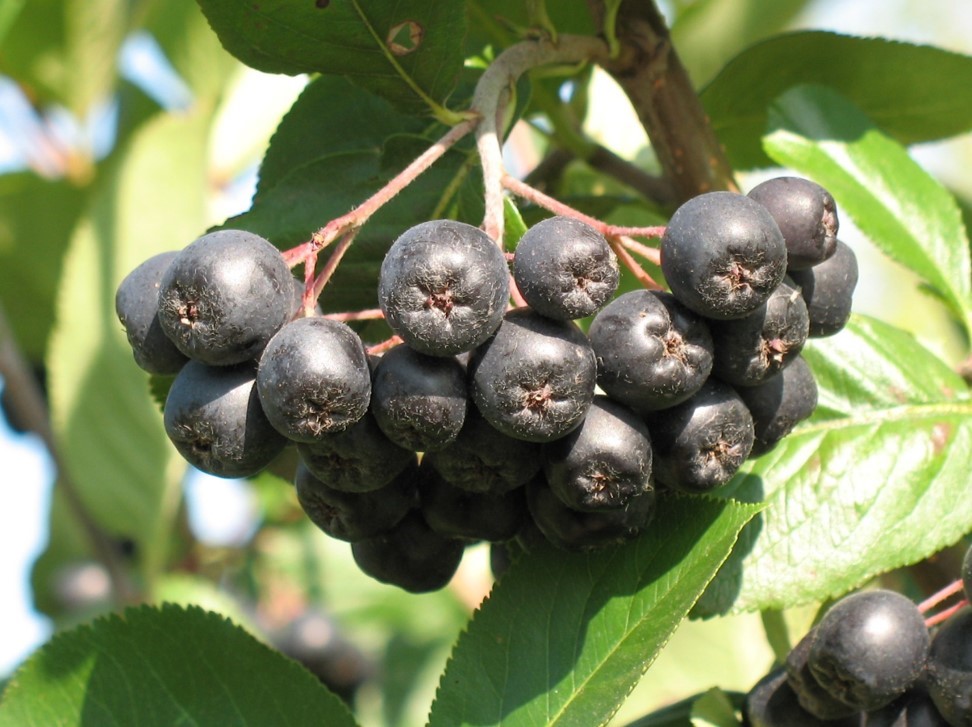 CREC aronia berries ready for picking.
CREC aronia berries ready for picking.
Several ND growers recently created and released a fruit-water product called ax-water and other Pride of Dakota businesses make jam, jelly, barbeque sauce and wine from ND fruit. National demand for aronia is surging, with the best prices available from manufacturers of organic, nutraceutical products that contain aronia extracts. North Dakota is well-positioned to enter this market: we have few pests and have growing conditions conducive to promoting high concentrations of polyphenolic compounds in our berries. But what does the real aronia market look like?
We hope to see you here at Field Day, Tuesday, July 17th for our Aronia update.
Kathy Wiederholt
Fruit Project Manager
Delays, Drills and Deadlines
Indications of an early spring were plentiful -- below average seasonal snowfall and a very nice March had set the scene. But Mother Nature’s delay came in April with very cold temperatures and no rain, keeping the drills out of the fields. There was very little concern this year about planting crops too early for crop insurance.
The opposite happened in May. May gradually warmed up, got hot and produced a few spotty rain showers. This was a real blessing as crop planting went into high gear. Many different crops needed to be planted in a short time frame. Final planting dates for crop insurance became the concern for this year.
There are many deadline dates for North Dakota farmers and seedsmen. These can include early ordering for discounts of crop inputs and seed, the wide array of coverages under crop insurance, and the field inspection report for seed fields.
June 15th is the State Seed Department (SSD) deadline to send in field inspection reports for early season seed fields. Late applications will have late fees added to them.
Application can be made using newly revised forms (obtained from your local county Extension county agent or by calling the SSD at 701-231-5400) or online at www.ndseed.com.

Field Inspection Application Form, Page 1
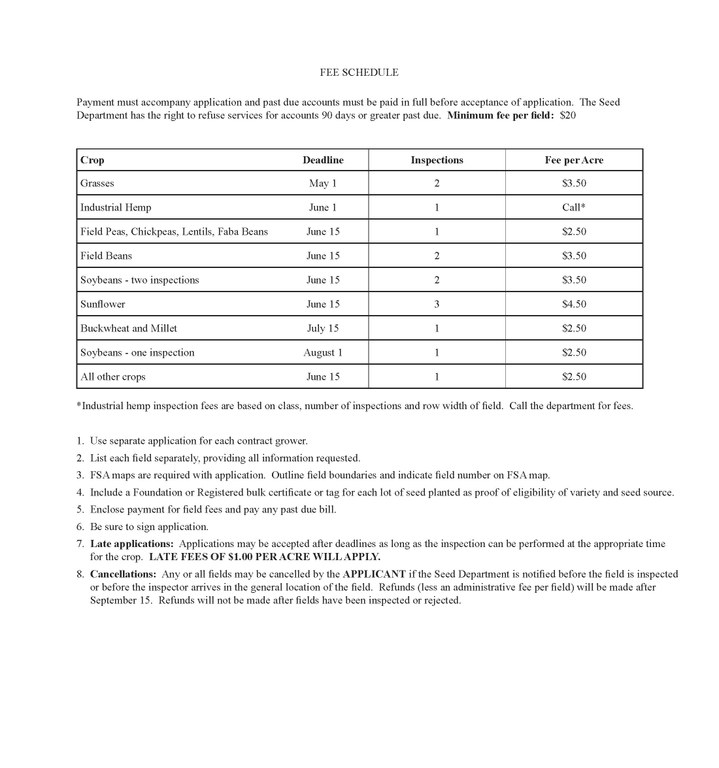
Field Inspection Application Form, Page 2
A few key highlights to be aware of when filling out the application:
1. Fee Schedule on the back page has eight important line items at the bottom of the page.
- Line item #3. Field boundaries can include a ditch, fence, 6 foot wide gap of mowing or tilling between crops.
- Line item #4. Bulk certificate or tag information is for the columns of crop variety, class planted and lot number(s) planted.
2. Durum fields have a special requirement regarding the previous crop column on the front page of the application. A previous two years’ crop history with no wheat must be included in the box.
3. Finally, make sure your field is ready for inspection. Have it sprayed to take care of noxious weeds and have isolation strips in place.
Have a good growing season, and THINK SAFETY AT ALL TIMES!
Dave Copenhaver
David.Copenhaver@ndsu.edu
Foundation Seedstocks Research Spec.


